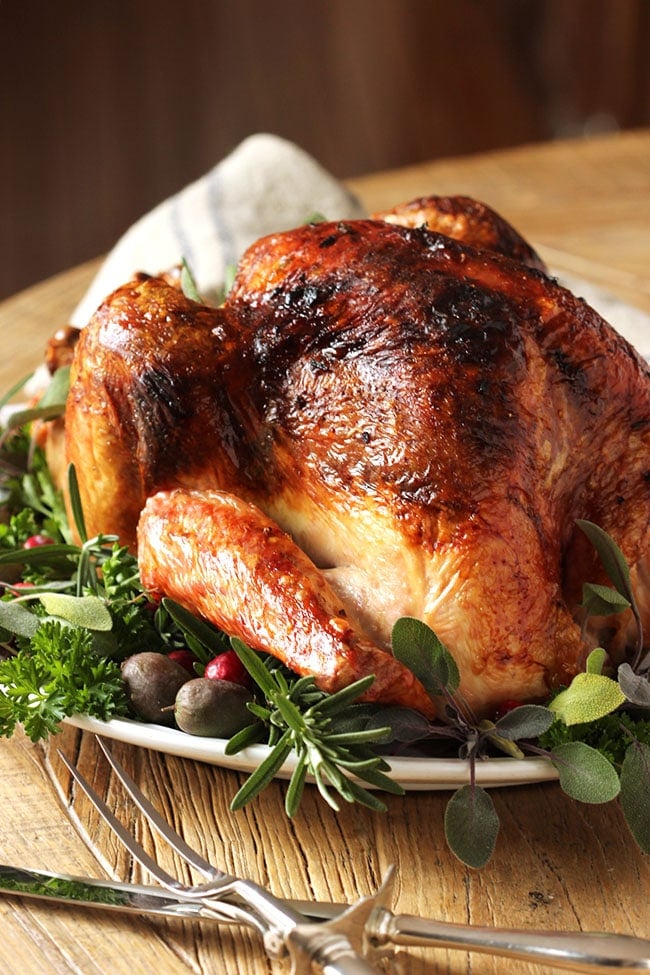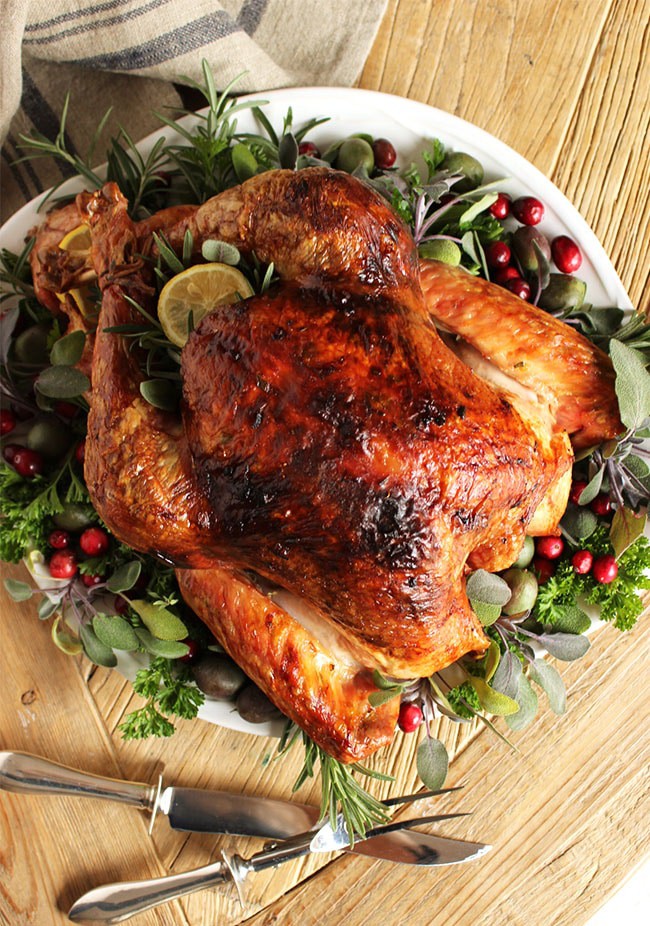CITRUS AND HERB BUTTER ROAST TURKEY RECIPE
The easiest turkey ever made. This Citrus and Herb Butter Roast Turkey Recipe is moist, tender and juicy. So simple to make and will definitely steal the show at your Thanksgiving dinner.

This is the lazy person’s Roast Turkey recipe. I say this because brining a turkey is such a mess and you MUST plan ahead AND you have to be sure the turkey is kept at the right temperature so it doesn’t contract any nasty organisms. With all the other details you need to worry about on Thanksgiving….sometimes it’s best to keep it simple. No Turkey Brine necessary.
Simple being….mixing up a citrus and herb butter concoction in a cereal bowl and smearing it all over the turkey…over AND under the skin. (Under the skin is very important!) This is no time to be squeamish.
This is the turkey of the future, or the present….my days of brining a 20 pound turkey are over for now. I agree, sometimes the brining process does give you an incredibly flavorful and moist turkey meat but so does not overcooking it!
So, if you want to take the easy route this year…try this “technique” and everyone will be thankful. Especially you. I will stress the importance of not overcooking the turkey….as tempting as it is. If you don’t own a meat thermometer go buy one now. Seriously…stop reading, go to your favorite kitchen supply store and buy this. It’s a life saver when roasting meats.
WHAT IS THE BEST TEMPERATURE TO COOK A TURKEY?
I like to sear the outside of my turkey at a raging 500 degrees to seal everything up. Kinda like a blanket to keep all those juices inside. So, while you’re prepping everything…preheat your oven to 500 degrees.
After 30 minutes, I turn the heat down to 350 degrees to finish the roasting process. At this point, you insert the meat thermometer to ensure you don’t over cook your turkey.

HOW LONG DO YOU COOK A TURKEY?
To roast your turkey, timing is everything if you want tender, moist turkey meat. Your cooking time is totally dependent upon the weight of your turkey and if you have decided to stuff it. Cooking times are generally 15 minutes per pound….give or take….stuffing or not.
I do NOT stuff my turkey, instead I cook the stuffing in a separate casserole dish to avoid any contamination. Remember, your turkey is safe for eating when it’s reached an internal temperature of 165 degrees….that’s when the probe thermometer is inserted into the thickest part of the thigh.
HERE’S A GUIDE TO PROPER COOKING TIMES ACCORDING TO THE USDA:
For an unstuffed turkey:
4-8 pounds 1 1/2 – 2 1/2 hours
8-12 pounds 2 1/2 – 3 hours
12-14 pounds 3 – 3 1/2 hours
14-18 pounds 3 1/2 – 4 hours
18-20 pounds 4 -4 1/2 hours
For a stuffed turkey:
6-8 pounds 2 1/2 – 3 hours
8-12 pounds 3 – 3 1/2 hours
12-14 pounds 3 1/2 – 4 hours
14-18 pounds 4 – 4 1/2 hours
18-20 pounds 4 1/2 – 5 hours
These times are all based on an oven temperature of 325 degrees so keep in mind we’re roasting our Citrus Herb Butter Roast turkey at a slightly higher temperature of 350 degrees. I, usually, find that my turkey is done about 1/2 hour less than the approximated times above.
HOW DO YOU ROAST A TURKEY IN THE OVEN?
Now that we have the oven temperature and oven times down….let’s get to the fun stuff! I like to fuss as little as possible with my turkey so I make a simple Citrus Herb compound butter to rub under and over the turkey. It’s easy, quick and adds so much flavor while keeping your turkey moist.
Preheat the oven to 500 degrees.
In a bowl, mix together the citrus herb butter.
Carefully, loosen the skin over the breast meat and legs but pushing your hand under the skin being careful not to puncture a hole in it.
Using your hands, spread the butter under the skin, inside the cavity of the turkey and then over the skin to coat.
Stuff the cavity of the turkey with garlic, oranges and herbs.
Truss the turkey by tying the legs together with kitchen twine.
Arrange the turkey in a roasting pan and transfer to the oven.
Roast the turkey for 30 minutes at 500 degrees and then turn the oven to 350 to finish roasting according the chart above.
Remove the turkey from the oven and rest for 20 minutes covered with foil.
Carve and serve.
DO YOU COVER A TURKEY IN THE OVEN?
To ensure even cooking and prevent the breast skin from browning too quickly, I cover the breast with a piece of foil that’s been shaped like a triangle. Brush the bottom side with oil to prevent sticking and place the foil on the turkey breast when you lower the oven temperature to 350 degrees.

This is the lazy person’s Roast Turkey recipe. I say this because brining a turkey is such a mess and you MUST plan ahead AND you have to be sure the turkey is kept at the right temperature so it doesn’t contract any nasty organisms. With all the other details you need to worry about on Thanksgiving….sometimes it’s best to keep it simple. No Turkey Brine necessary.
Simple being….mixing up a citrus and herb butter concoction in a cereal bowl and smearing it all over the turkey…over AND under the skin. (Under the skin is very important!) This is no time to be squeamish.
This is the turkey of the future, or the present….my days of brining a 20 pound turkey are over for now. I agree, sometimes the brining process does give you an incredibly flavorful and moist turkey meat but so does not overcooking it!
So, if you want to take the easy route this year…try this “technique” and everyone will be thankful. Especially you. I will stress the importance of not overcooking the turkey….as tempting as it is. If you don’t own a meat thermometer go buy one now. Seriously…stop reading, go to your favorite kitchen supply store and buy this. It’s a life saver when roasting meats.
WHAT IS THE BEST TEMPERATURE TO COOK A TURKEY?
I like to sear the outside of my turkey at a raging 500 degrees to seal everything up. Kinda like a blanket to keep all those juices inside. So, while you’re prepping everything…preheat your oven to 500 degrees.
After 30 minutes, I turn the heat down to 350 degrees to finish the roasting process. At this point, you insert the meat thermometer to ensure you don’t over cook your turkey.

HOW LONG DO YOU COOK A TURKEY?
To roast your turkey, timing is everything if you want tender, moist turkey meat. Your cooking time is totally dependent upon the weight of your turkey and if you have decided to stuff it. Cooking times are generally 15 minutes per pound….give or take….stuffing or not.
I do NOT stuff my turkey, instead I cook the stuffing in a separate casserole dish to avoid any contamination. Remember, your turkey is safe for eating when it’s reached an internal temperature of 165 degrees….that’s when the probe thermometer is inserted into the thickest part of the thigh.
HERE’S A GUIDE TO PROPER COOKING TIMES ACCORDING TO THE USDA:
For an unstuffed turkey:
4-8 pounds 1 1/2 – 2 1/2 hours
8-12 pounds 2 1/2 – 3 hours
12-14 pounds 3 – 3 1/2 hours
14-18 pounds 3 1/2 – 4 hours
18-20 pounds 4 -4 1/2 hours
For a stuffed turkey:
6-8 pounds 2 1/2 – 3 hours
8-12 pounds 3 – 3 1/2 hours
12-14 pounds 3 1/2 – 4 hours
14-18 pounds 4 – 4 1/2 hours
18-20 pounds 4 1/2 – 5 hours
These times are all based on an oven temperature of 325 degrees so keep in mind we’re roasting our Citrus Herb Butter Roast turkey at a slightly higher temperature of 350 degrees. I, usually, find that my turkey is done about 1/2 hour less than the approximated times above.
HOW DO YOU ROAST A TURKEY IN THE OVEN?
Now that we have the oven temperature and oven times down….let’s get to the fun stuff! I like to fuss as little as possible with my turkey so I make a simple Citrus Herb compound butter to rub under and over the turkey. It’s easy, quick and adds so much flavor while keeping your turkey moist.
Preheat the oven to 500 degrees.
In a bowl, mix together the citrus herb butter.
Carefully, loosen the skin over the breast meat and legs but pushing your hand under the skin being careful not to puncture a hole in it.
Using your hands, spread the butter under the skin, inside the cavity of the turkey and then over the skin to coat.
Stuff the cavity of the turkey with garlic, oranges and herbs.
Truss the turkey by tying the legs together with kitchen twine.
Arrange the turkey in a roasting pan and transfer to the oven.
Roast the turkey for 30 minutes at 500 degrees and then turn the oven to 350 to finish roasting according the chart above.
Remove the turkey from the oven and rest for 20 minutes covered with foil.
Carve and serve.
DO YOU COVER A TURKEY IN THE OVEN?
To ensure even cooking and prevent the breast skin from browning too quickly, I cover the breast with a piece of foil that’s been shaped like a triangle. Brush the bottom side with oil to prevent sticking and place the foil on the turkey breast when you lower the oven temperature to 350 degrees.
Source link from : https://thesuburbansoapbox.com/citrus-and-herb-butter-roasted-turkey/
BERITA LENGKAP DI HALAMAN BERIKUTNYA
Halaman Berikutnya